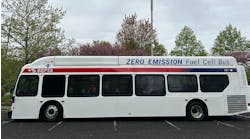The long-awaited process to bring passenger rail back to the Lehigh Valley has left the station. If it ever reaches its final destination, the process will take at least a decade and need plenty of funding.
Several people were on hand Wednesday morning, both virtually and in person, for the unveiling of the Lehigh Valley Passenger Rail Feasibility Analysis that was prepared by PennDOT and consulting company WSP. The meeting was hosted by the Lehigh Valley Transportation Study.
“This is the very, very initial study on passenger rail for this region,” said PennDOT representative Angela Watson. “This is the study I would call akin to a feasibility study to kind of inform you as to what are the potential likely corridors that you could consider should you decide as a community to move forward and consider passenger rail for the Lehigh Valley.”
The report has identified the five “most likely” corridors for restoring passenger rail service from the Lehigh Valley to New York, Philadelphia or Reading, out of 12 possible corridors that were examined. The five corridors are:
- Allentown to New York via Hackettstown: Utilizing the Norfolk Southern Railway to Phillipsburg and Dover & Delaware River Railroad to connect with the NJ Transit Morris & Essex Line in Hackettstown, New Jersey.
- Allentown to New York via High Bridge: Utilizing the Norfolk Southern Railway to connect with the NJ Transit Raritan Valley Line in High Bridge, New Jersey.
- Allentown to Philadelphia via Lansdale: Utilizing the Norfolk Southern Railway to Bethlehem, Lehigh Valley Rail Management within Bethlehem, Saucon Rail Trail ( SEPTA) to Coopersburg, Upper Bucks Rail Trail ( SEPTA) to Quakertown, East Penn Railroad ( SEPTA) to Telford, and Pennsylvania Northeastern Railroad ( SEPTA) to connect with the SEPTA Lansdale Doylestown Line in Lansdale.
- Allentown to Philadelphia via Norristown: Utilizes the same routes as the above corridor, then connects with the SEPTA Norristown Line in Norristown.
- Allentown to Reading: Utilizes the Norfolk Southern Railway to connect with the planned Schuylkill River Passenger Rail Authority service between Reading and Philadelphia.
Trip times to New York were estimated to be around 2 ½ hours, while Philadelphia is about 1 hour, 45 minutes and Reading is 46 minutes.
The study was started in August 2022 and was scheduled to be completed in fall 2023. However, delays from WSP slowed things down.
Liz Hynes, a senior transportation project manager from WSP, called the analysis a “high-level planning exercise that didn’t go too in depth.”
For instance, the Norfolk Southern Railway, SEPTA or New Jersey Transit were not contacted for the analysis. All three will play an important role in the future as their tracks will need to be used.
“So we’re looking at what is in the right of way now,” Hynes said. “We also developed a very basic service plan, which is really kind of just a work by scheduling of when trains would run, so that we could look at operational considerations at a high level. For that we assumed that there would be three round trips a day. It’s just an assumption for the purposes of our planning and analysis.”
More details, such as where intermediate stations will be placed, how former stations in Allentown, Bethlehem or Easton will be rehabilitated or the environmental impact of rail services, will be in future reports.
Which 5 routes are being considered for Lehigh Valley passenger train service? Here are the pros and cons for each
“There’s still a very long process between where we are now and getting even into construction,” Hynes said. “And that will incur billions in professional services costs, regardless of whether that work is done in house or by consultants.”
Capital costs for the five main routes range between $450 million and $739 million, with the lines to Philadelphia being more expensive. Track infrastructure is mostly in place for the New York routes. The Philly routes would require new track to be laid as some of the route has been converted to rail trails.
The feasibility of the Reading route will depend on whether that region’s efforts to re-establish passenger rail service to Philadelphia is successful.
“You would have to look to federal money for probably a large cost for capital,” Watson said. “We don’t have a dedicated passenger rail pot of funds per se. It would require a match to the federal dollars and part of that would be local.”
She said that will have to be carefully examined as well as operations if the service starts.
“People sometimes don’t think ahead about offsetting that cost of revenue,” Watson said. “It could be substantial.”
The LVTS said the Pennsylvania Legislature will have the final word on funding because passenger rail lines do not turn a profit. Lawmakers will have to agree to cover any operating shortfalls in any new line created.
The timeline presented has 14 steps that is estimated to run between 10 and 12 years before the first train leaves the station. A sponsor, such as a regional transit authority, will have to be brought on board.
“We put together a very conservative setting from from where we are today to the point where you’ve identified your project sponsor, all the way into step 14, operation of the service,” Hynes said. “So we’re showing a very rough 10- to 12-year timeline for that right now.
“There’s a lot of federal dollars out there, a lot of momentum for passenger rail, which is great for moving things forward. But the flip side of that is entering into any federal process also takes some time. So we wanted to be realistic about the amount of time all of this could take,” Hynes said.
Similar projects in Scranton and Reading were each accepted into the Federal Railroad Administration’s Corridor Identification and Development program last year and received $500,000 in federal funding to complete a service plan.
The Lehigh Valley needed the PennDOT plan before it can be accepted into the federal program, which could happen next year.
LVTS Coordinating Committee Chair Rick Molchany suggested reaching out to the Scranton and Reading groups to get some tips for moving forward.
During the question-and-answer period, Brett Webber, an Easton resident and a representative of the Rail Passengers Association, said the return of trains will have a positive impact environmentally and urged cooperation with Norfolk Southern, pointing out that the railroad has worked with other states in establishing passenger rail.
“This is a huge investment in the future of the commonwealth,” Webber said. “All of the economic challenges are fit on the return side with huge economic benefits that need to be at least established hypothetically, both in jobs, tax revenue and new infrastructure and new development in all the cities in the ABE, and including Reading as we think about this more broadly.”
The LVTS will study the analysis over the next few weeks and will collect public comments via the Lehigh Valley Planning Commission website. Another special meeting will be scheduled for May.
Previous efforts
The last passenger train from the Lehigh Valley to New York was in 1961 and service to Philadelphia ended in 1979. There were numerous attempts to revive service over the decades.
Kirk Raup, a passenger rail advocate, in the mid-1980s proposed using mostly federal money to connect Bethlehem rail lines to Lansdale, effectively linking the region to SEPTA.
A separate effort in the 2000s by businessman Paul Marin sought to get federal money to link to New Jersey Transit to create a connection to Manhattan. That effort failed and chances dimmed further when a $250,000 study in 2010, commissioned by Valley planners but performed by New Jersey transit officials, determined it would cost nearly $700 million to link to Manhattan.
The study also estimated that because not enough Valley residents would use rail, the system would have to be heavily subsidized annually by taxpayers.
The LVTS launched its own study in 2015, dubbed “Road to Rail,” with the backing of the mayors of Allentown, Bethlehem and Easton. But Norfolk Southern Railway officials declared in 2016 that the company’s tracks between New York and the Lehigh Valley were too busy with freight traffic to accommodate any passenger routes.
Still, Amtrak ran two passenger train trips — the Autumn Express — through the region that October. The trips, which Amtrak said were the first passenger trains on those routes since 1984, quickly sold out. The trains followed the former route of the Queen of the Valley passenger train, going from Penn Station in New York to Phillipsburg, then crossing the Delaware River into Easton. From there, they continued through Freemansburg and south Bethlehem before passing the rail yards in east Allentown and continuing along Basin Street, into Emmaus and on to Harrisburg. They did not stop in the Lehigh Valley, traveling about 50 mph as they rumbled through the region.
Read the full Lehigh Valley passenger train study
Morning Call reporter Evan Jones can be reached at [email protected].
©2024 The Morning Call. Visit mcall.com. Distributed by Tribune Content Agency, LLC.


